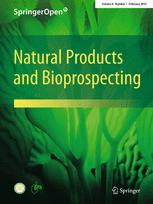|
|
Six New Vibralactone Derivatives from Cultures of the Fungus Boreostereum vibrans
Collect
He-Ping Chen, Zhen-Zhu Zhao, Rong-Hua Yin, Xia Yin, Tao Feng, Zheng-Hui Li, Kun Wei, Ji-Kai Liu
Natural Products and Bioprospecting. 2014, 4 (5): 271-276.
DOI: 10.1007/s13659-014-0029-z
Phytochemical reinvestigation on the cultural broth of Boreostereum vibrans led to the isolation of six new vibralactone derivatives, vibralactone N(1), vibralactone O(2), vibralactone P(3), 10-lactyl vibralactone G(4),(3S*, 4R*)-6-acetoxymethyl-2, 2-dimethyl-3, 4-dihydro-2H-chromene-3, 4-diol(5), vibralactone Q(6). Their structures were elucidated by extensive spectroscopic methods.
References |
Related Articles |
Metrics
|
|
|
Comparative Study on “Long-Dan”, “Qin-Jiao” and Their Adulterants by HPLC Analysis
Collect
Fang-Fang Liu, Yan-Ming Wang, Hong-Tao Zhu, Dong Wang, Chong-Ren Yang, Min Xu, Ying-Jun Zhang
Natural Products and Bioprospecting. 2014, 4 (5): 297-308.
DOI: 10.1007/s13659-014-0039-x
"Long-Dan" and "Qin-Jiao" are two important TCM herbs since ancient times in China. In the Chinese Pharmacopoeia, the dried roots and rhizomes of four species from the genus Gentiana, e.g. Gentiana manshurica, G. scabra, G. triflora and G. rigescens, are recorded under the name of Gentianae Radix et Rhizoma("Long-Dan" in Chinese), while the other four species from the same genus including G. macrophylla, G. crassicaulis, G. straminea and G. duhurica are recorded and used as the raw materials of Gentianae Macrophyllae Radix("Qin-Jiao" in Chinese). On the basis of the establishment of a validated HPLC-UV method for quantifying simultaneously, five iridoid glycosides, e.g. loganic acid(1), swertiamarinin(2), gentiopicroside(3), sweroside(4) and 2'-(o, m-dihydroxybenzyl) sweroside(5) have been used successfully as chemical markers for the comparison of the species used as "Long-Dan", "Qin-Jiao" and their adulterants in the present study. The results suggested that four iridoid glycosides 1-4 commonly existed in both "Long-Dan" and "Qin-Jiao", while 2'-(o, m-dihydroxybenzyl) sweroside(5) also existed as one of the major components in "Dian-Long-Dan" species. Moreover, the contents of compounds 1-5 were various in different "LongDan" and "Qin-Jiao" species. Herein, we profiled and compared three "Long-Dan" species, four "Qin-Jiao" species and five adulterants by applying multivariate statistical techniques to their HPLC data sets to establish the differences and/or similarities.
References |
Related Articles |
Metrics
|
|
|
A Novel Insulinotropic Peptide from the Skin Secretions of Amolops loloensis Frog
Collect
Guo-Xiang Mo, Xue-Wei Bai, Zong-Jie Li, Xiu-Wen Yan, Xiao-Qing He, Ming-Qiang Rong
Natural Products and Bioprospecting. 2014, 4 (5): 309-313.
DOI: 10.1007/s13659-014-0037-z
Various kinds of biologically active peptides have previously been isolated from the skin secretions of Amolops loloensis frog, such as antimicrobial peptides, bradykinin-like peptides and algesic peptides. A novel insulinotropic peptide named amolopin was identified in A. loloensis frog's skin secretion. Its primary structure sequence was determined by Edman degradation as: FLPIVGKSLSGLSGKL-NH2. BLAST search indicates that the amino acid sequence of amolopin is quite different from other known insulin secretagogues, including mastoparan, exendins and a-latrotoxin, nor does it like incretins(e.g. glucagons like peptide-1 and glucose-dependent insulinotropic ploypeptide) either. However, amolopin shows certain structural similarity with amphibian antimicrobial temporins and vespid chemotactic peptides isolated from Vespa magnifica. Amolopin can stimulate insulin release in INS-1 cells in a dose-dependent manner. Primary investigation on its action mechanisms reveals that amolopin does not increase the influx of Ca2+. In conclusion, a novel 16-amino acid peptide with insulin-releasing activity is initially discovered from the skin secretion of A. loloensis frog. Further work is necessary to evaluate its potential as novel anti-diabetic candidate.
References |
Related Articles |
Metrics
|
|

